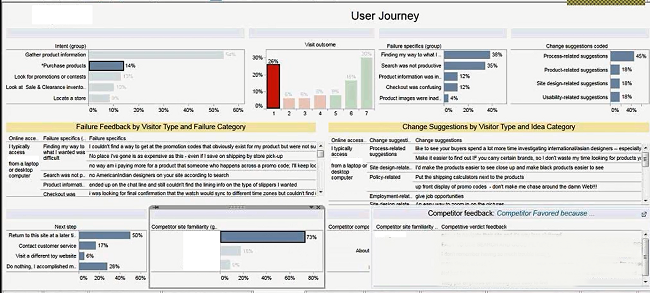
Usability Sciences magnifies results with Tableau
Tableau: Can you tell us a little bit about your customers and what your company does?
Rebecca Ratliff, Director of Operations at Usability Sciences: We serve a lot of Fortune 100 to Fortune 1000 companies in a number of industries, but primarily e-commerce and banking. The work that we do for all of these clients, we do online intercepts or surveys. And the problem that we're trying to solve from them is primarily usability issues.
Tableau: And how does Tableau fit in?
Rebecca: What Tableau has done for us is allow analysts to really magnify what they can do for their clients in a very short period of time.
Unsere Analysten haben früher 80 % ihrer Zeit darauf verwendet, Daten in Excel hin- und herzuschieben, und nur 20 % darauf, statische PowerPoints zu erstellen und tatsächlich zu analysieren. Jetzt verwenden wir 80 % unserer Zeit auf die Analyse.
Tableau: How so?
Rebecca: Our analysts were spending 80 percent of their time pushing data around in Excel, and 20 percent of their time putting together static PowerPoints and, you know, doing analysis. Analysts want to do analysis, not push data around. So now we spend 80 percent of our time on analysis.
Now the analyst gets to spend time doing analysis. And for us, that's critical. And it allows us to not just do a two-dimensional pivot table, but to take a dashboard and look at so many variables at one time, and actually drill down to an individual user, click on that user, and actually display their click stream through the website to understand not only how did they answer the questions, but what was their experience on the website?

Tableau: That’s fantastic! What sort of insights are your analysts providing to your customers?
Rebecca: Our clients want their visitors to their websites to be able to have a seamless experience.
If you think about the speed of the Internet today, how fast our clients have to make changes, utilizing Tableau in an interactive way to get rich insights for them and give them insightful recommendations on how to change their site so that they can increase their revenue has totally changed how we do business with our clients.
We can collect data for a week now, put together dashboards and begin to show our clients what's actually happening on their website, where people are failing.
So our role with them is even if we can move the needle a little bit, let's say during their checkout process or the checkout flow, if we can move the needle just a little for our large clients, it can mean millions of dollars a year.
Tableau: Can you give us an example where this happened?
Rebecca: Okay, well, take for example, we were engaging with a site that primarily sold clothing items. And one of the insights that we gained through the research was that when people buy an article of clothing and they love it. Six months later, it was impossible for visitors to actually navigate and find that product.
So we gave the recommendation to the client. The client now added in their search field the ability for someone to put the information in the tag, the product number (snaps), bingo, right to the product. That increased their sales by millions and millions of dollars per year, just that one insight.
Tableau: So getting those insights faster must really help your clients! Are there other benefits you’ve seen from your use of Tableau?
Rebecca: Tableau has changed not just our client's life, but Usability Sciences' life. The acquisition of clients completely changed. Clients are very impressed when they see Tableau. Everybody can roll out survey data, but taking survey data, putting it in a dashboard and interacting with your clients with a Tableau dashboard is very powerful.
We had a lot of annual engagements. Tableau, and because of the power of Tableau, we now have clients that engage with us for multi-year engagements. All of those things were things that we didn't really anticipate, but have been a wonderful benefit of Tableau.